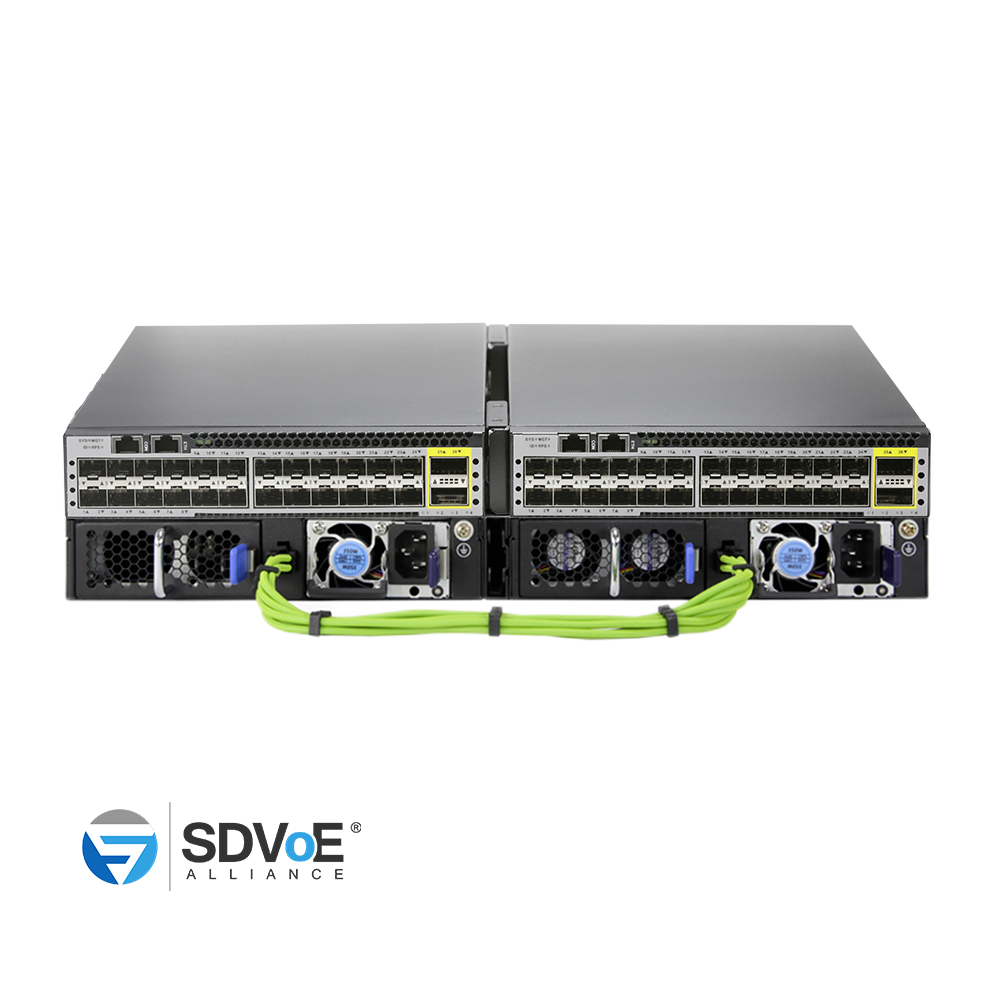Description
S7606X-2Z 40G Optical Datacenter Switch, which is designed on a domestic high-performance Switch Chip, competently meets the requirements of Metro, Enterprise, Data Center, and Hyperconverged infrastructure(HCI) networks.
S7606X-2Z-SI:6x40G QSFP+ ports, 2x100G QSFP28 ports, Fixed Power and Smart Fans, Half-width, support two physical hot-backup in 1U space.

The S7606X-2Z 40G Optical Switch is adopts a unique product design, which can realize physical dual-machine deployment in 1U space and supports rich dual-machine redundant protocols to achieve high reliability of physical TOP and protocols.
Unique cross-switch power redundancy ensures network availability even when a single node power subsystem fails.

The S7606X-2Z-SI is adopts a unique product design, which can realize physical dual-machine deployment in 1U space and supports rich dual-machine redundant protocols to achieve high reliability of physical TOP and protocols.
In default, the S7606X-2Z has 6 40G and 2 100G ports, 8 physical port in total. But, the port type are alterable, which means a 40G or a 100G port can be split into quadruple 10G or 25G links. Whether 40G, 100G, 10G or 25G have a LED indicator in the front panel to clearly display the link status separately.
For easy operation, the S7606X-2Z have four built-in configuration templates to cover requirements for the number of ports/links. These are 6*40G + 2*100G; 24*10G + 2*100G; 24*10G + 8*25G and 32*10G.
S7606X-2Z support for a variety deployment in 1U space. These are single switch deployment、wall-mount deployment and two switch combine deployment which is efficiently space using and good way to achieve hot-backup.
Innovative to Integrate SDVoE API Server
SDVoE (Software Defined Video over Ethernet) technology offers high performance, low latency, and reliability for transmitting 4K/8K or higher resolution images, ensuring an excellent visual experience in medical, enterprise, education and other industries. The built-in SDVoE API Server simplifies network architecture and reduces project costs.
System Design for Green and Energy Saving
Intelligent FAN adjustment and real-time power consumption monitoring technology are provided for the cost of maintenance redundancy and help to build a green and energy saving networks.
Customized Profile for Different Deployment Scenarios
The Flexible Table Management (FTM) technology offers multiple table size configuration profiles as optimized choices for different network scenarios.
Intelligent Ethernet OAM: completed network fault management and performance guaranty
With the IEEE802.1ag and ITU-T Y.1731 end-to-end OAM, Ethernet service providers can monitor the services, survey the end-to end performance and ensure the service quality match the agreement.
The fault management technique includes CCM, LTM and LBM. Performance targets include measure for latency and jitter.
S7606X-2Z support remote management,network monitoring,network fault indication,remote loopback and MIB parameter retrieval according to the standard 802.3ah EFM.
Data Center Features
S7606X-2Z supports leading edge Data Center features: Priority Flow Control (PFC), explicit Congestion Notification (ECN) and Data Center TCP, etc.
Support MLAG (Multi-Chassis Link Aggregation) to aggregate links across different devices. MLAG can build an Active-Active system to improve the reliability of the network links from single board grade to device grade. MLAG use a peer link between to devices to aggregate two devices and make them as one device logically. Ports of two different devices join the aggregate ports together and all port can transmit the data traffic. MLAG need to management the device respectively, but the configurations are easier than stacking, reboot is NOT required after MLAG is configured. Forwarding and configuring are processing on local device, in normal condition the traffic do NOT transmit trough the peer link, the bandwidth of peer link is not the bottleneck of the network and the latency is low.
System Design for Green and Energy Saving
Intelligent FAN adjustment and real-time power consumption monitoring technology are provided for the cost of maintenance redundancy and help to build a green and energy saving networks.
Customized Profile for Different Deployment Scenarios
The Flexible Table Management (FTM) technology offers multiple table size configuration profiles as optimized choices for different network scenarios.
Intelligent Ethernet OAM: completed network fault management and performance guaranty
With the IEEE802.1ag and ITU-T Y.1731 end-to-end OAM, Ethernet service providers can monitor the services, survey the end-to end performance and ensure the service quality match the agreement.
The fault management technique includes CCM, LTM and LBM. Performance targets include measure for latency and jitter.
S7606X-2Z support remote management,network monitoring,network fault indication,remote loopback and MIB parameter retrieval according to the standard 802.3ah EFM.
Data Center Features
S7606X-2Z supports leading edge Data Center features: Priority Flow Control (PFC), explicit Congestion Notification (ECN) and Data Center TCP, etc.
Support MLAG (Multi-Chassis Link Aggregation) to aggregate links across different devices. MLAG can build an Active-Active system to improve the reliability of the network links from single board grade to device grade. MLAG use a peer link between to devices to aggregate two devices and make them as one device logically. Ports of two different devices join the aggregate ports together and all port can transmit the data traffic. MLAG need to management the device respectively, but the configurations are easier than stacking, reboot is NOT required after MLAG is configured. Forwarding and configuring are processing on local device, in normal condition the traffic do NOT transmit trough the peer link, the bandwidth of peer link is not the bottleneck of the network and the latency is low.






.png)


